COMPARATIVE MORPHOLOGICAL STUDY OF SOME GENERA FROM THE TRIBE NOTOCACTEAE Buxb. (CACTACEAE)
Dr. Irina M. Vasiljeva
Scientific Curator of the Succulent Collection in Bot. Gard. of the Bot. Inst-t of Russian Academy of Science
From jornal "SUCCULENTS / Sukkulents bilingual", 2001 № 1(2), p.11-19.
The taxonomical position of two genera of Cactaceae – Eriocactus Backbg. and Brasilicactus Backbg., which were separated from Notocactus (K.Schum.) Berger on the base of the peculiar flower and fruit structure (Backeberg, 1942) remains indefinite up to date. A lot of modern authors consider these genera to be the synonyms of Notocactus. We imply the works of Buxbaum (1958); Hunt (1973) and Eggli and Taylor (1971).
Others ascribe all of them including Notocactus to Parodia Speg. genus. Among them there are the works of Barthlott (1988) and Barthlott and Hunt (1993). All these concepts are based on the macromorphological characteristics or on the studies of the seeds using electronic microscope.
Our complex comparative-morphological research of these genera was undertaken to clarify the taxonomic independence of Eriocactus (Photo 1 – 2) and Brasilicactus (Photo 3) genera and their relationship with Notocactus (Photo 4 – 5) and Parodia (Photo 6 – 7). The study was fulfilled on the base of greenhouses in the Komarov Botanical Garden of the Botanical Institute in St. Petersburg.
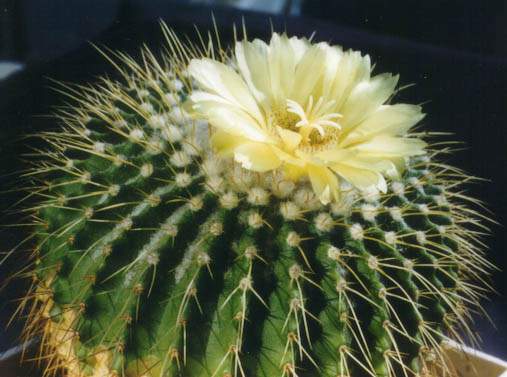 |
| Photo 1. Eriocactus schumannianus |
According to the aim of study, 20 species from genus Parodia, 19 Notocactus species, 2 Eriocactus species and 2 Brasilicactus species were investigated. It was established that Parodia representatives are the most diverse in forms, dimensions, structure and color of flower. Corolla colors vary from red via orange to yellow. Flower tube is rather short, densely covered with whitish brown tomentum. Degree of the tube acrotony varies. Stigmata and stamen filaments are yellow, stamens are free or seldom joined to the lower part of a tube base. The flower size varies from 0.8 up to 3.5 cm in diameter and from 1 up to 3.5 cm in length.
The Notocactus flowers are larger than those of Parodia. They are broadly funneled, yellow, seldom yellowish-pink. The corolla tube is brown-tomentose with long bristles, has no acrotony features. The distinguishing feature of all Notocactus species is the purple stigmata. Two subgenera of the genus differ in flower size and the corolla's tube length.
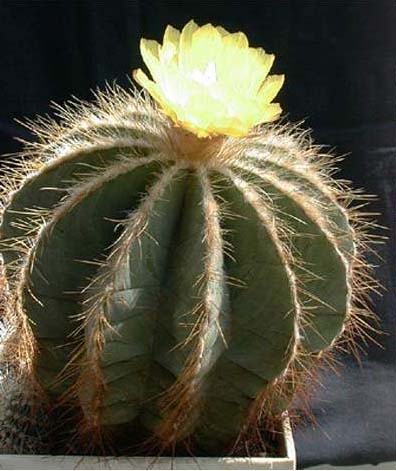 |
| Photo 2. Eriocactus magnificus |
The Notocactus subgenus corolla tube is more or less short, thick with free yellow stamen filaments. The diameter of the flowers is 3.2–4.8 cm, their length is from 3 up to 6.2 cm. The corolla tube of NeoNotocactus is longer than that of Notocactus subgenus. Larger, widely opened almost always yellow flowers with purple stigmata and no acrotony undoubtedly allow to separate Notocactus from Parodia.
We can see more significant differences while investigating Eriocactus and Brasilicactus flowers. The Eriocactus genus has the largest flowers (up to 6 cm in diameter and 6 cm in length). They are broadly funneled, lemon-colored, with thick short corolla tube covered by dense brown-yellow tomentum with the brown bristles and no acrotony. In addition stigmatas and free fillaments are yellow.
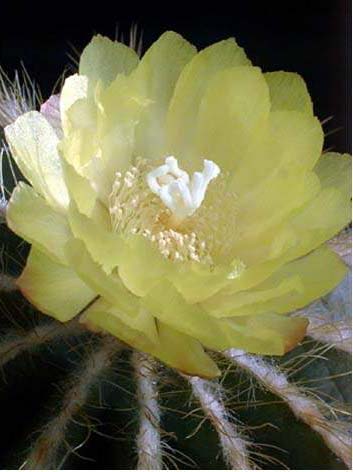 |
| Photo 2. Eriocactus magnificus |
The Brasilicactus flowers are the smallest (1.2–1.4 cm in diameter and 2.2–2.4 cm in length). They are red or greenish-yellow. The corolla tube is yellow not long. Their tomentum has long white bristles evenly spread from the base to the top of the tube; there is no acrotony.
Our study of flower morphology of Eriocactus and Brasilicactus proves their generic independence and doesn't allow to unite them with either Parodia or Notocactus.
Our investigation of fruits has revealed that Brasilicactus fruits are the most distinct. They are spherical-round, berry-like, very small, from 0.5 up to 0.8 cm in diameter, becoming black while maturing. They bear well-observed areoles with long light spines on their surface. The funneled tomentum unlike other genera is absent. After ripening fruits open releasing seeds.
 |
| Photo 3. Brasilicactus hasselbergii. |
Contrast to Brasilicactus the fruits of Eriocactus are the largest, they can be 2 cm in diameter and more. They are widely round and thickly covered with brownish-white tomentum and rather long light yellow bristles. Eriocactus fruits open transversely at the base, producing a great amount of seeds, much more than other genera of the tribe.
The fruits of Notocactus can be divided into two groups: in Notocactus subgenus they are rather partially juicy (according to the Buxbaum classification). They are elongated, about 2 cm long and 1 cm wide, covered with brown tomentum and with the brown bristles, open longitudinally. Unlike of the previous subgenus, NeoNotocactus fruits are thin-walled, hollow, dry, covered by tomentum and long brown bristles. They open not longitudinally but transversely at the fruit base. NeoNotocactus fruits are the closest to Parodia fruits, which also have long shape, thin-walled too, dry, covered with brown tomentum and prickles and open at the base or fall apart.
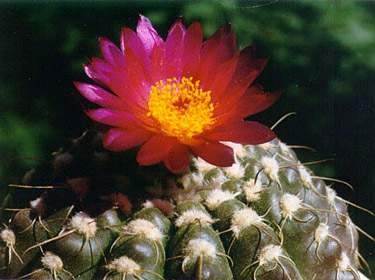 |
| Photo 4. Notocactus uebelmannianus |
If we consider the similarity in seeds in ProtoParodia and NeoNotocactus subgenera, we can make a conclusion about their definite original affinity. Nevertheless the further evolution of Parodia and Notocactus genera went on in different ways. Parodia genus still being in the active evolutional process of development gave the greatest species variety while Notocactus remains on its final evolution stage.
Thus the facts we've gathered about the fruit structure, proved once more the generic independence of Brasilicactus, Eriocactus and Notocactus, and don't allow to unite them with Parodia.
The pollen grains morphology of 12 Notocactus species, 4 Parodia species, 2 Eriocactus species and 1 Brasilicactus species was studied with the help of the light and electronic scanning microscopes. Pollen material was collected from the alive plants which are cultivated in the Botanical Garden of the Komarov Botanical Institute greenhouses.
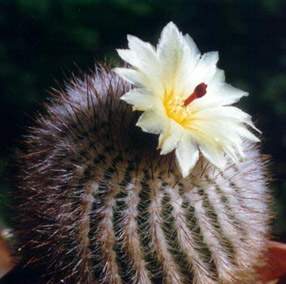 |
| Photo 5. Notocactus scopa |
Notocactus pollen grains are colpate, spheroid roundish or round-triangular from polar view and elliptic in equatorial view. The polar axis is 49–102 microns (мm) and the equatorial diameter is 45–88 мm. There are from 3 up to 12 colpi and more. We mean the sparcely-colpated type. The exine is thick from 21 up to 30 мm forming polar thickening on the apocolpium. Their sculpture is perforated and prickled. The prickles are small with more or less sharpened apex, densely spread on the surface. The perforations are of round shape. The frequency of spreading and the size depend on the species. The surfaces of membrane colpus and the mesocolpiums do not differ from each other.
We managed to separate three palinological groups on the base of such morphological indications as the pollen grain size, number of colpis perforations' frequency and size.
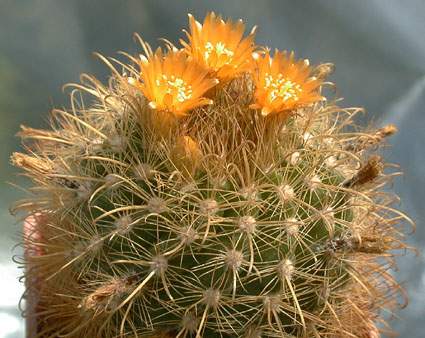 |
| Photo 6. Parodia hausteiniana |
The first palinological group (Notocactus muricatus, N. tabularis and N. concinnus) has the largest pollen grains. Their polar axis is from 77 up to 102 мm and equatorial diameter is from 66 up to 88 мm. They are loosely colpated and have large perforations from 0.1 up to 1 мm in diameter.
The second palinological group (Notocactus mammulosus, N. ottonis, N. rutilans, N. submammulosus, N. linkii) are characterized by pollen grains of medium size. Their polar axis is from 64 up to 71 мm and the equatorial diameter is from 54.5 up to 59 мm. Besides the preponderating three-colpated grains we also can meet in the samples a certain amount of from six up to twelve colpated forms, the perforations being a little smaller from 0.05 up to 0.8 мm in diameter.
The third palinological group (Notocactus purpureus, N. herteri, N. mueller-melchersii) has the smallest pollen grains. Their polar axis is from 49 up to 59 мm and their equatorial diameter is from 45 up to 54 мm. They are three-colpated. Four-, six- and twelve-colpated grains are single. The perforations are small from 0.01 up to 0.03 мm in diameter.
 |
| Photo 7. Parodia sanagasta |
The generic independence of Eriocactus based on palinological facts wasn't proved. Two investigated species – E. warrasii and E. leninghausii have the same form and the shape of the pollen grains as in Notocactus. Their polar axis is from 58 up to 69 мm and the equatorial diameter is from 45 up to 57 мm. The preponderating type is three-colpated, solitary grains are four - six - twelve-colpated. The diameter of perforation is from 0.05 up to 0.7 мm. According to their features the Eriocactus pollen grains can be refered to the second palinological group of Notocactus.
We also have studied Brasi1icactus hasselbergii species. The polar axis of its pollen grains is from 50 up to 52.5 мm, the equatorial diameter is from 44 up to 48 мm. The sculpture is prickled-perforated. The perforations are very densely located. Their diameter is from 0.1 up to 0.5 мm. The prickles are very small and spread over the surface more rarely than in the other species.
Considering some macro-morphological peculiarities, we mean smaller flowers with very short prickled tubes, smaller strongly prickled berry-shaped fruits, the peculiar form of the germ during the early ontogenesis, and paying attention to some palinological peculiarities, we can suppose that Brasi1icactus has its own generic independence. Parodia genus is the most distinct among all the genera we have investigated. Its pollen grains are spheroid, they have three, seldom four, five colpates. They are the smallest among others and are from 44 up to 52 мm in diameter, their exine is from 2.1 up to 2.7 мm.
Thus our palinological and morphological investigation, in spite of rather close taxonomical relations within the studied genera, prove the generic independence of Brasilicactus and doesn't allow to unite Notocactus, Eriocactus and Brasilicactus genera with Parodia genus.
The study of Parodia seeds (11 spp), Notocactus (9 spp), Brasilicactus (2 ssp) and Eriocactus (1 sp) was undertaken to check the taxonomic independence of Eriocactus and clarify its relationships with Notocactus and Parodia. The material was gathered in the succulent collection of Botanical Garden at the Komarov Botanical Institute. During the studying we paid attention to their form and size, color, form and size of hilum and the surface of testa.
During the research it was established that representatives of subgenus Obtextospermae of Parodia possess half-spherical seeds. Their size is 0.5–0.8 mm. They have pillow formed strophiole which is covered by aril-like brown cuticle. Testa cells are elongated with flattened nipples, which are closely arranged to each other. Such a seed structure is typical for the most primitive Cactaceae representatives.
The seeds of ProtoParodia representatives are also of rather primitive structure. They are a little bit larger than the previous subgenus representatives, from 0.6 to 1 mm. They are brownish-black, dull, partially covered with cuticules, oblong from conical or truncate-ovoid to practically spheroid. The strophiole is very small or absents, seed testa has nipples or half-round tubercules.
In the mostly specialized subgenus Parodia the seeds, because of absence of perisperm, are very small, 0.3–0.4 mm and round. The strophiole is rather big, often exceeds the seed size. Seed testa is light or dark brown, smooth, shining, with flat cells without cuticle.
The Notocactus seeds by their morphology are the closest to the primitive ProtoParodia subgenus. Their testa is also covered with large and small tubercules. It is dull and black, but seed size is a little bigger – 0.9–1.4 mm. They are bell-shaped with convexed edges. The hilum is round, it's larger than in Parodia representatives. The strophiole of Notocactus seeds is much smaller than in Parodia, often is absent. The surface of Notocactus seeds shows the different degree of the knoll reduction. They are the most developed in NeoNotocactus subgenus and the most flattened in Notocactus subgenus.
As compared to Parodia there is no microspermy in Notocactus genus. One can suppose that this is absolutely other brunch of evolution. The evolution of the genus must have gone on from flat testa structure to the tubercular one. While in Parodia genus it could be vice versa - from tubercular to flattened, small seeded form. Consequently it is impossible to unite the genera.
The seeds of the Brasilicactus species are also the most close to the subgenus ProtoParodia in their form, size and the seed testa. The seed form is elongated, flattened from the sides, that's why the hilum also has oval shape. The seeds are 1.1–1.3 mm in length and 0.6–0.8 mm wide. Seed surface is dull, dark brown or black. The nipples are arranged in a row, one after another. The surface structure of Brasilicactus seeds has some similar peculiarities as in Notocactus subgenus Neo Notocactus.
The seeds of Eriocactus are the most isolated by their morphology. They are definitely not of microspermous genus, as it was considered earlier. It was thought to be transitional from Notocactus to Parodia. They are 1.2–1.5 mm long and 0.6–0.8 mm wide. The seed form is absolutely unique. It narrows to the apex and widens to the base. That's why the hilum is so large and round in outline. The seed testa is glossy black or gloomy black. Their cells are definitely formed on the surface. They are long and have caterpillar- or cord-like form and what's more, on the surface of such a cell one can definitely see flattened tubercles.
Considering a number of macro-morphological characteristics, which distinguish Eriocactus both from Notocactus and Parodia, we can conclude that Eriocactus is undoubtedly an independent genus.
Our study of seeds peculiarities also proves the taxonomical independence of the Brasilicactus genera and doesn't allow to unite it either with Notocactus or Parodia.
To study early stages of ontogenesis of discussed genera, seeds of Eriocactus (2 spp), Brasilicactus (2 spp), Notocactus (7 spp) and Parodia (5 spp) were sown. First shoots appeared in 10–14 days. It should be mentioned that seedlings of these genera were spheroid or long-spheroid with juicy acuminated or round cotyledons and juicy hypocotyl. The seedlings of Brasilicactus are long and the length of hypocotyl exceeds its width in 1.5 times. In Eriocactus and Notocactus genera the hypocotyl length is equal to its width. Parodia seedlings are extremely variable. In subgenus ProtoParodia hypocotyl length exceeds its width twice, in subgenus Parodia the length is a bit smaller than its width, and in the subgenus Obtextospermae hypocotyl is equal in its length and width.
As for cotyledon form, in Eriocactus they are round with concavity in center and convex near growth point. Brasilicactus and Parodia have round and acuminate cotyledons. The Notocactus seedlings bear acuminate cotyledons while in NeoNotocactus cotyledons are round.
A normal stem bears nipples which correspond to leaves, they start to grow in 19–22 day. The first nipples pair which corresponds to the first pair of leaves is located opposite to cotyledons, the second pair is perpendicular to the first one and one nipple retards in development. The spines appear almost immediately on top of the nipples. The first nipple pair has 4-6 whitish semi-transparent soft radial spines, spines on the third and the fourth pair of nipples are more thick, firm and reddish. Only at the end of the first year the central spines start to appear. At this time Brasilicactus seedlings bear from 9 up to 11 ribs. Only in this genus at the end of the third month there are from 28 up to 32 nipples. In mature state Brasilicactus develops up to 90 ribs. In Notocactus, Eriocactus and Parodia the number of nipples doesn't exceed 18 and the ribs are formed at the end of the second year. 'Ihe adult Eriocactus has no more than 14 ribs while in Notocactus and Parodia the number of ribs is about 15–20.
On the base of the initial stages of development of Eriocactus, Brasilicactus, Notocactus and Parodia we can make the following conclusions.
Brasi1icactus is the mostly isolated genus. Its seedlings have hypocotyl with length which in 1.5 times exceeds its width and the amount of nipples at the early stages of ontogenesis exceeds considerably the number of the nipples in other genera.
The seedlings of Eriocactus bear hypocotyl with equal length and width and peculiar round cotyledons.
The variety of seedling forms in Notocactus was observed, but the clear delimitation of the subgenera has been made according to the cotyledon forms. In the Notocactus subgenus they are always sharpened and round in NeoNotocactus.
The greatest variety of seedlings and cotyledons can be seen in Parodia. May be this fact proves the opinion of those authors, who consider this genus to be the base in forming the row of the other taxonomically close genera. If Brasilicactus and Eriocactus were segregated rather early during the evolution, Notocactus is still being in the process of the active speciation. Its well developed subgenera, according to the cotyledon form, can give rise to the independent genera.
Thus we consider that the study of flowers, fruits, pollen grains, seeds and the ontogenesis of the Notocactus, Eriocactus, Brasilicactus genera we've made in comparison with Parodia genus shows enough differences which allow to preserve Eriocactus and Brasilicactus in the genus rank and not to unite them either with Notocactus or Parodia.
All the photos are courtesy of Valery A. Zlotin, Moscow, URL: http://www.vzlotin.boom.ru





